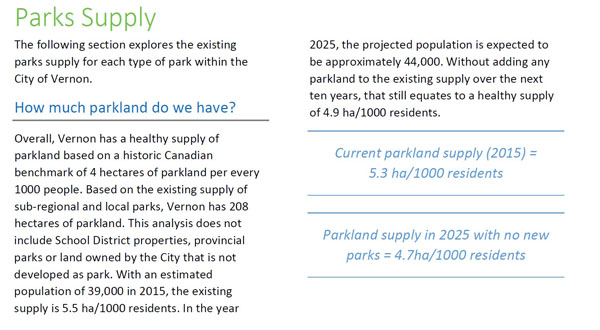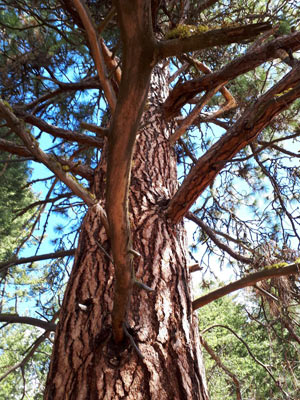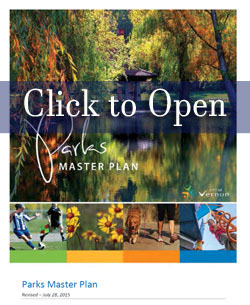
Parks Planning
Vernon's 2015 Parks Master Plan:
Depriving Future Generations of Much-needed Parkland
Since 1978, the provision of parks and recreation services has been provided under the umbrella of the Greater Vernon Parks and Recreation District (GVPRD). The GVPRD included the City of Vernon, District of Coldstream, and Electoral Areas B and C of the Regional District of North Okanagan (RDNO). Managing parks on a regional basis makes a lot of sense, since residents of the City of Vernon often use parks in Coldstream and Areas B and C, and vice versa. It also helps with parkland acquisition, since the pooled fund is larger than if each jurisdiction had to acquire their own parks.
In 1991, the first Parks and Recreation Master Plan for the GVPRD was adopted. Many of the recommendations in that plan were implemented, and it was again updated in 2004.
The 2004 GVPRD Parks Master Plan identified a large deficiency of parkland in Greater Vernon, based on the current standard of 4 hectares (10 acres) per thousand population.

Unfortunately, the different jurisdictions within the GVPRD rarely agreed on issues related to parkland development. Between 2012-2014, the directors effectively dismantled the GVPRD, instead coming up with a new arrangement called the "Greater Vernon Sub-Regional Parks and Trail Service Agreement". Under this new arrangement, each jurisdiction would be responsible for funding, developing, maintaining, and operating all local parks within their boundaries. Sub-regional parks would still be managed by the RDNO.
Surplus of Parkland? ... Not!
As part of this agreement, the fund for parkland acquisition was also divvied up between the parties. This allowed each jurisdiction to make their own decisions regarding parks planning. As a result, the City of Vernon and the District of Coldstream each decided to draw up their own Parks Master Plan.
Amazingly, instead of admitting a large deficiency of parkland as the 2004 plan did, the City of Vernon now boasted in their 2015 Parks Master Plan that they had a surplus of parkland!

Parkland in 2004 ≠ Parkland in 2015
How did they do this without adding any significant new parks?
Here's how: they simply decided to count every scrap of land (let's call them "remnant parks") that developers didn't want, which are now owned by the city — regardless of usefulness.
This was not the case in the 2004 Parks Master Plan. In 2015:
- Ravines, wetlands, cliffs, and other remnants of development suddenly became part of the parkland tally;
- Many school playing fields are now included — which weren't before;
- Parks and green spaces in remote communities such as Predator Ridge and Adventure Bay (satellite communities annexed into the city) are included;
- Gullies in the Foothills are now "parks";
- Obscure, undeveloped "parks" that few Vernonites have ever heard of (CEC Young, Bella Vista Lot A, Foothills Hitchcock, Airport Lands, Coursier Park, Pottery Ravine Park, Marshall Wetlands, Anderson Ranch Property, to name a few) contribute to the total parkland tally.
By adopting this strategy, the parkland tally increased to 208 hectares. Based on a population of 39,000 (vs. 58,000 for Greater Vernon), the parkland supply works out to 5.3 hectares per thousand population.

In addition to grossly misstating the parkland inventory tally, the city's new Parks Master Plan also failed to identify the acute shortage of parks in much of the city. For example:
- East Hill, with a population of 7330, has only one significant park — Lakeview Park. It is 2.03 hectares, yielding a ratio of 0.3 hectares per thousand;
- In the Foothills, if you ignore the ravines and the remnant land by Hitchcock Road, the 2.27 hectare park on Whistler Place gives a ratio of 1.17 hectares per thousand;
- This situation is played out across many other Vernon neighbourhoods.
Parks Master Plan ≠ Foothills Knoll Park
As you can see, Vernon's new Parks Master Plan is fatally flawed. That's a shame. How can the city effectively plan for parkland acquisitions when its parkland tally is so far out of whack? Quite simply, it can't. If decision makers believe that no more parks are needed in Vernon, then there is obviously no urgency to purchase new parkland.
On the Foothills Knoll, the City of Vernon has made no attempt to purchase land for a park at the top of the hill, and there is no Master Plan to ensure a well-designed, expansive park. Development planning is essentially piecemeal, and the city seems content to end up with just another "remnant park" at the top of Foothills Knoll. This despite so many community groups advocating for a large park on Foothills Knoll.

